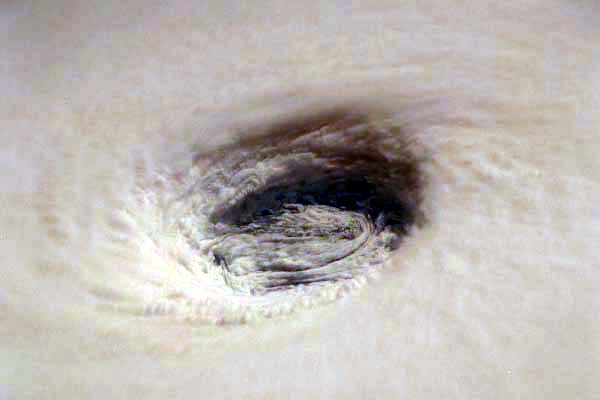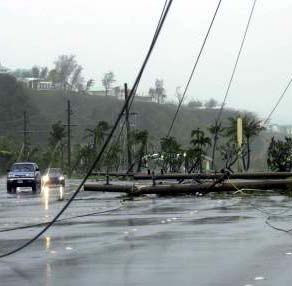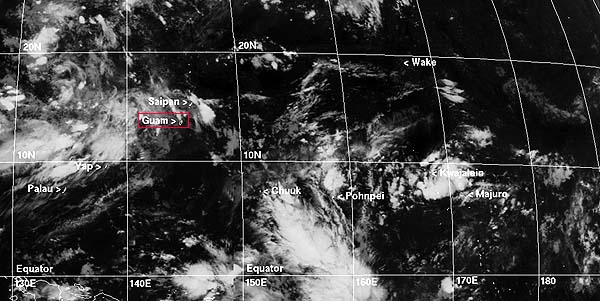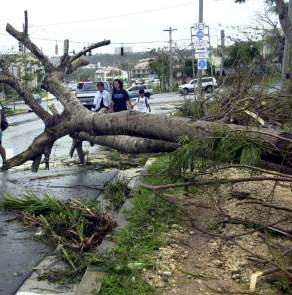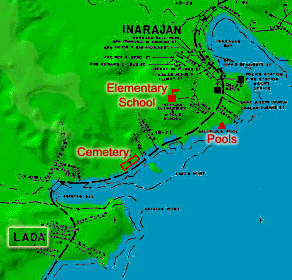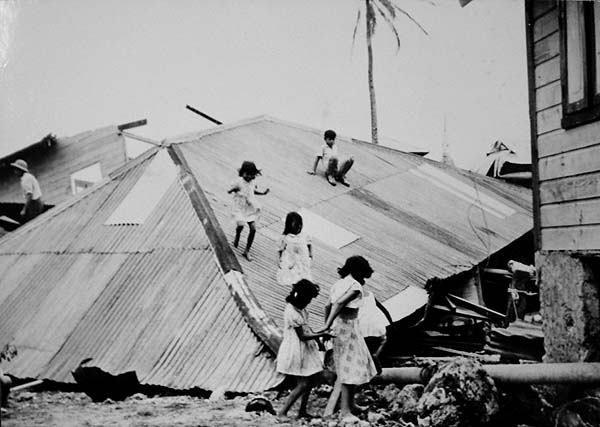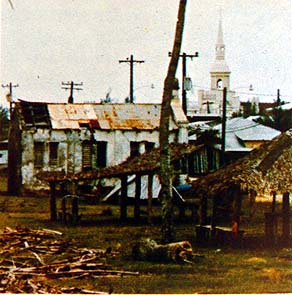 |
 |
 |
 |
||||
|
|
|
|
|
|
|
|
|
|
|
|||||||
|
|
|
|
|
|
|
"The wind is the eyes and the ears," Ben Meno explains. "It travels and it makes sounds, and it makes the trees sing a song. If you live in an area where there’s a lot of bamboo, when the wind blows hard, the bamboos squeeze one another, and they make songs! Different tunes. Anyone who lives next to a bamboo patch, you can sit down and hear all the different tunes coming from the bamboo, from high pitch to low pitch. "The wind from the typhoon, you can hear the rumbling, the different
tunes of the wind as it travels. The circulation, the pounding. Many
people don’t realize that there is beauty in these things."
|
||
|
|
||
|
"The wind is to give us life also. The destruction, like that of earthquakes and typhoons, is to wake us up, change things: our vision, our thinking, the way we see things. And many times I sit down—take the typhoon that’s coming. Friday we should have a typhoon [Typhoon Chata'an; July 6, 2002]. "And you know the reason why we’re having a typhoon? Every time Guam gets broke, God gives us a typhoon. He creates destruction. I don’t want a typhoon, but it always happens that every time Guam gets to be broke, a typhoon comes and destroys the island. Then the Federal Government comes in and bails us out." Concrete utility poles were toppled in front of Alupang Beach Tower in Tamuning by Typhoon Chata'an. |
|
|
"I don’t know if you’ve ever experienced a hurricane or a typhoon. I hope you don’t! It will be very interesting for you. For me, I no longer fear those things. I have seen it come and go 100, 200, 300 times. So I don’t worry. But for you, I know you’re going to worry, because it’s about life and death. You have to know what to do, you have to be prepared, and preparation, you have to know what to prepare, and where to go, and when to react. "I enjoy typhoons. On typhoon, I never run away. I come out here and stand here, even with big waves coming in, or I go by Gådao’s Cave, and I stand on that big rock, and I just sit down and watch, get my coffee and whatever, and I just sit. I enjoy it. But children should never go outside in a typhoon. It is too dangerous, the flying objects in the strong wind. We should fear them, but because I have experienced it tremendously, I make myself stand there. "But for people who haven’t experienced that, my advice is, don’t do it."
|
|
|
|
|
|
|
"The wind, the pounding of the wind and the impact of it on the trees around your house," Bill exclaims, "Oh I’ll tell you. I live in an area where the trees are so mature that you hear the breaking of the branches and if you’re in a cement house, it’s as if the cement is just going to break apart. That’s how bad it is. The windows would start to shake, the sliding windows start to shake like crazy. "I remember the first part of Typhoon Omar, we got up because these metal shutters, they’re okay as long as they’re not hit by anything, but something hit one in the middle and that whole window just went, and we were in the living room. And thank God I was in the hallway, because the hallway was between two walls. And that’s where we all stayed, but the whole living area from the sliding door, it just burst open and we all ran. Boy, that was so scary! "So when typhoon comes now, even living in a cement home, I’ll tell you, I still get very, very scared."
|
||
|
|
||
| "That typhoon started probably about 2:00 in the afternoon and all the way up the way to about 10, 11:00 in the evening when it started to subside. But even in the early morning, it was still very windy. "Then right after the typhoon, the suffering begins, water shortage. That’s why I have a storage of these big containers, so that when a typhoon is going to occur, those are filled. Because after the typhoon there is virtually no water. And no power. I don’t mind so much the power, but no water? That’s the worst thing. "And then that long silence in the evening, because you normally hear music, you hear all kinds of things, vehicles and all that. But after typhoons, by 8:00 pm for at least a month, it’s very, very quiet, and that’s when you hear the chickens all over the place." Right: A fallen tree on Pale San Vitores Road in Tumon, after Typhoon Chata'an. Masako Watanabe photograph, Pacific Sunday News.
|
|
|
|
"There was one time I was in my classroom," Therese recalls, "and they already declared it Condition One, which is when the typhoon is going to hit in 24 hours or even less. I look out, and I see the Sasalåguan Pools have filled with water, it’s gone to the top, and where the sea wall is near the cemetery, the water has already reached the road. "So here am I in Inarajan, and my house is there in Lada. How am I going to get home? So I just quickly secured all I could and got in my car and drove very, very carefully, and the water was creeping onto the road already! I’ve heard horror stories where people—I don’t know what they’re doing out on the road during a typhoon—but their cars get washed into the cemetery, with them in it. I don’t want that to happen to me!"
|
|
|
|
"Once when I was a child, and we were here during a typhoon, our house had concrete walls and a tin roof, but the only room that was all concrete was the bathroom. So my mom, my dad, my brother and myself all went into the bathroom. And it got so bad, where the roof was flapping—my dad had secured it enough that the roof didn’t go flying off, but the sound of it was so scary, we got out of the house. "I think we were in the eye of the typhoon already, so it was calm, and we made our way to my uncle’s house nearby. And then the worst of it came: the tail-end of the typhoon, and that was when we saw the ocean go up my uncle’s driveway. "There was a little peep hole that we made in the wood covering the window, so we could see what the weather was like outside, and that was scary watching the water come up that road, up the hill. The coconut trees that are on the beach area here in Agfåyan? We couldn’t see those coconut trees anymore. That was scary."
|
||
|
|
||
|
|
|
“I hear stories that back in the 50’s there used to be a bakery here, a gas station,” Therese states. “There were many houses here before the typhoons. Typhoon Karen and Typhoon Pamela were the most devastating typhoons. After Typhoon Karen I know that the majority of the houses were gone. As the houses were destroyed, people just kept moving inland, and so that is the reason why you don’t see many houses along the bay. "They try to think about what is going to happen in the next typhoon. Most of the houses are built with concrete instead of wood because they know what kind of destruction the typhoons can cause. And it’s really hard for big families to pick up and go move somewhere else.”
|
||
|
|
||
"When you’re told the typhoon is coming," Bill advises, "being a local person, you know that immediately you’ve got to evacuate that place. There’s no way that you’re going to stay in that village and think you’re going to survive. You need to move." “I remember Typhoon Allen in 1949 that my mother was talking about,” Bill recounts, “that it practically just wiped out the entire village. In fact that was the reason we moved out of the village of Inarajan and up to Belen. "Right after Typhoon Yuri and Typhoon Russ, the black sand was three or four feet deep right into the village. The big rocks that were there on the road, unbelievable! After the typhoon, the National Guards were there to get those things all shoveled.”
|
|
|
|
|
|
"People are used to typhoons, so they learned to cope with it, " Rufo adds. "They know when to leave, when to stay. I don’t think that younger people have the same sense of typhoons, that respect for natural catastrophes, I don’t think it’s there. Now when we have typhoons, people want to party, throw a typhoon party, which is ridiculous. Things have changed a lot, they really have."
Typhoons involve not just winds, of course, but also rain.
|
||
|
|
||
|
|
|
|
|
|

|
| Inarajan Home | Map Library | Site Map | Pacific Worlds Home |
|
|
|
|
|
|
|
|||
| Copyright 2003 Pacific Worlds & Associates • Usage Policy • Webmaster |
|||
